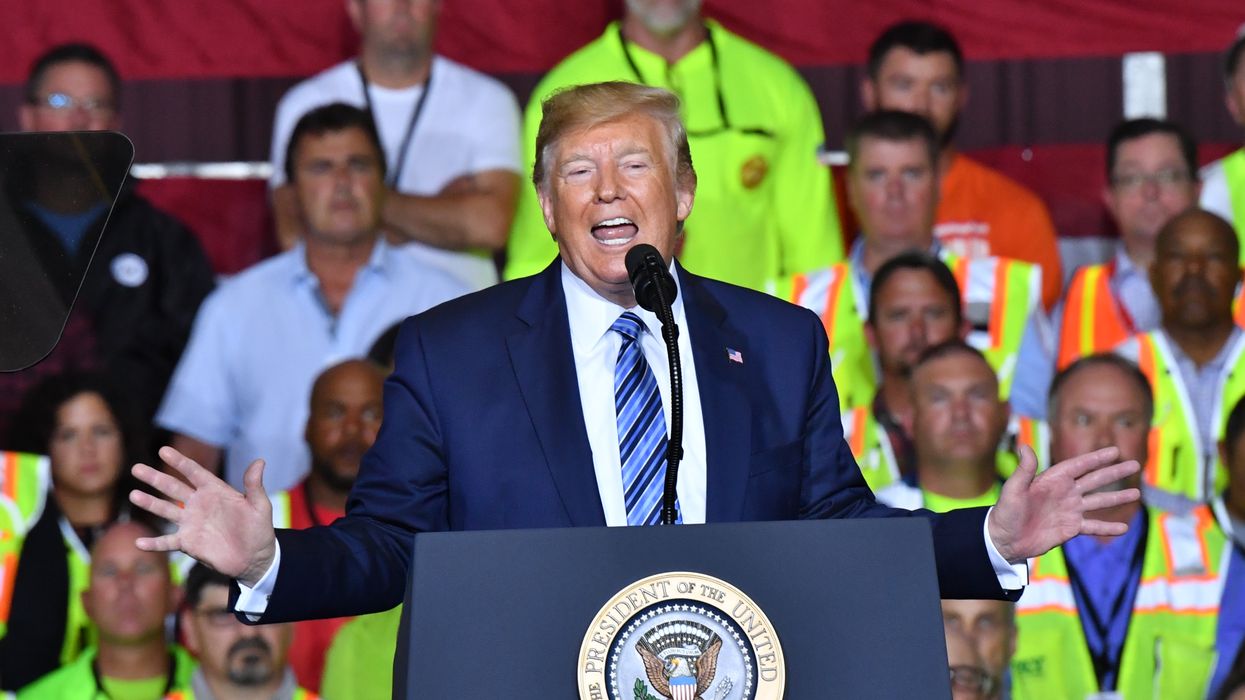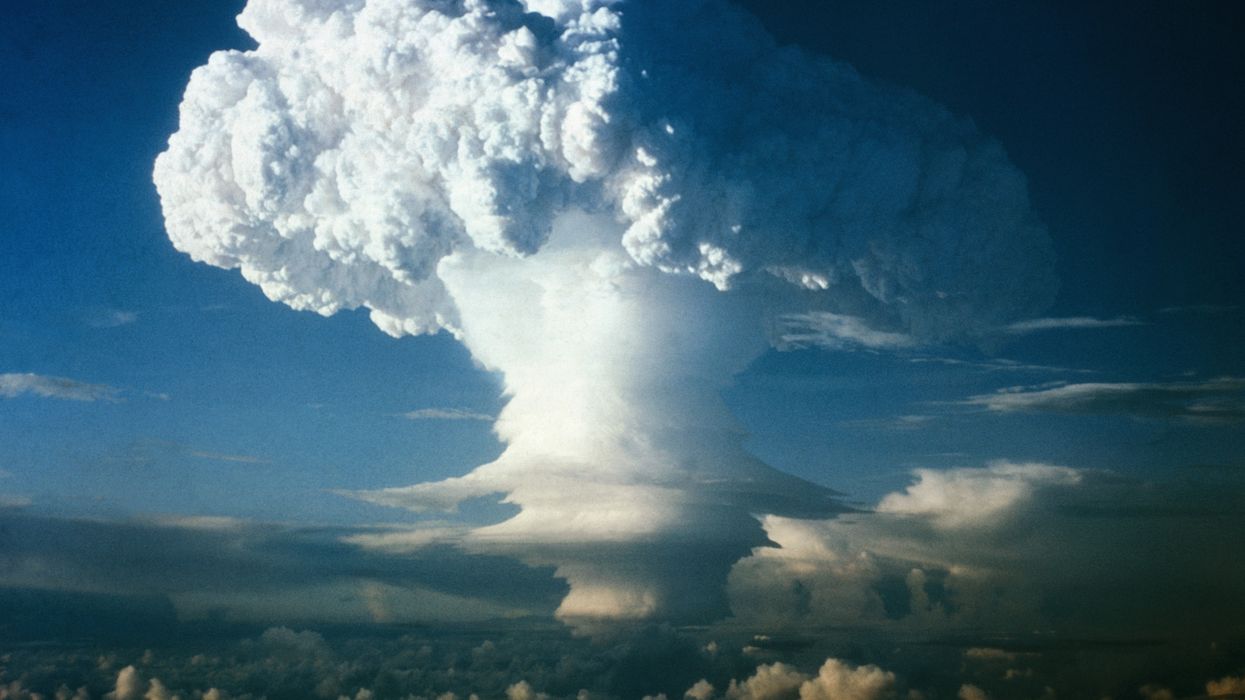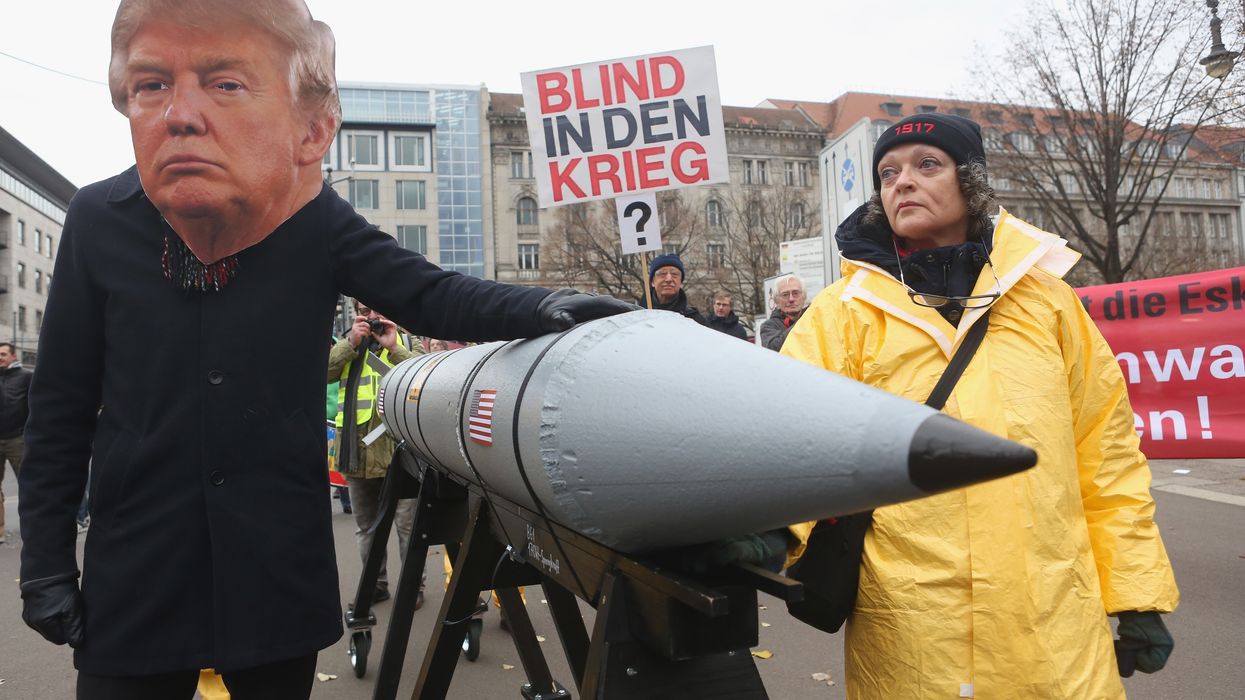Trump: A Symptom of the End of the World?
The president of the United States is deeply involved in dealing with the two ways we human beings have figured out how to destroy ourselves (and potentially so much else on this planet): nuclear war and climate change.
When I began TomDispatch in the wake of the 9/11 attacks and the invasion of Afghanistan, believe me, the world did not look good. But I guarantee you one thing: If you had told me then that, almost a quarter of a century later, the president of the United States would be Donald J. Trump (and had explained to me just who he was), I would have thought you an idiot first class or totally mad! Donald J. Trump as president of the United States, not just once, but twice? In what century? On what planet? You must be kidding! (And what a dreadful joke at that!)
Now, of course, I would have to put all of that in the past tense (and probably add yet more exclamation points)!!
Once upon a time, you could never have convinced me (or just about anyone else) that we would find ourselves in such a world. Living in it now, however, it’s all too easy to see—yes!—President Donald Trump as a (if not the) crucial actor (making up his lines as he goes along) in a potentially devastating planetary drama still distinctly in development. (And I’m not even thinking about the possibility that, in the not-too-distant future, he might actually order some kind of invasion of, or assault on, Venezuela!) What’s rarer is to imagine him as a genuine symptom of this world’s end (at least as we human beings once knew it).
(And yes, there are indeed a lot of parentheses in this piece so far, perhaps because, at almost 81 and a half, I feel increasingly parenthetical to this eerily strange world of ours.)
He’s clearly right that heaven will indeed be a problem for him, since he’s so intent on sending us all, himself included, to hell in a handbasket.
Okay, I know, I know, all of that couldn’t sound more extreme. And unfortunately, that’s not even the half of it. After all, at this very moment, the president of the United States is deeply involved in dealing—in a fashion that would once have seemed as unimaginable as Donald Trump himself—with the two ways we human beings have figured out how to destroy ourselves (and potentially so much else on this planet): nuclear war and climate change.
Think of “President” Trump, in short, as a twofer when it comes to potential planetary destruction. And once upon a time (twice upon a time?), who would have imagined that possible when it came to a president of the United States? I’ll say it again: the “president” (and given the strange circumstances of this world of ours, that word does seem to me to need quotation marks!) of—nowhere else but—the United States of America! (And yes, we do seem to be on a planet where exclamation points can’t be used too often!! In fact, we may truly need some new symbol for the extremity of this world of ours!!!)
Okay, let me calm down a bit. After all, so many years after he first entered the White House, it’s true that, if you check statistician Nate Silver’s website, the president’s approval figures are indeed dropping significantly. But that may not, in the end (and “end” is anything but an inappropriate word here), truly matter to the man who clearly thinks better of himself than anyone else on this planet and possibly any other planet, even if he does now worry about whether or not, in the next life, he’ll actually make it to heaven. (“I want to try and get to heaven, if possible,” he said recently. “I’m hearing I’m not doing well. I am really at the bottom of the totem pole.”)
Nonetheless, I’d advise Saint Peter, if he’s still holding the keys to that kingdom’s gateway, to watch out. For his own safety, I’d urge him to consider burying those keys and stepping aside. (Oh, and let me use parentheses—and dashes—again here to suggest, sadly enough, that Donald J. Trump couldn’t be less dashingly parenthetical in this all too strange world of ours and, for all we know, the next one, too.) In fact, should he indeed surprise himself and the rest of us by making it to heaven, count on something else—and yes, I’ll need a colon here (lots of punctuation being necessary to deal with You Know Who): Expect him to tear down those ancient pearly gates and begin building a heavenly—or do I mean hellish?—version of Mar-a-Lago up there; in short, a new East Wing of heaven.
Living in a Sci-Fi World
In the 1950s and 1960s, from Brave New World and 1984 to Fahrenheit 451, I grew up on dystopian fiction and sci-fi, but honestly, there wasn’t a shot in hell of a chance that Aldous Huxley, George Orwell, or Ray Bradbury, amazing as each of them was, could ever have imagined Donald Trump. (Think of him, in fact, not as Big Brother but perhaps as Humongous Brother.) If any of them had done so back then, rest assured that they wouldn’t have sold a copy of a book with such a ludicrous, unrealistic character and plot line. It tells you something that former Vice President Dick Cheney, who died recently, the fellow who became “the Darth Vader” of the administration of George W. Bush and helped launch the disastrous post-9/11 American wars in Afghanistan and Iraq, by opposing Trump, now seems almost like a positive figure by comparison.
After all, today, Donald J. Trump has his hands on (all over, in fact) the two distinctly apocalyptic and all too science-fictional ways we humans have discovered to do in ourselves and much of the rest of the planet. Only recently, he demanded that the US military start testing nuclear weapons for the first time since 1992. In fact, on Truth Social, just minutes before he met with China’s President Xi Jinping, he stated that he had ordered “the Department of War” to resume such tests. “I’m saying that we’re going to test nuclear weapons like other countries do, yes,” he recently told CBS’ Norah O’Donnell. “Russia’s testing, and China’s testing, but they don’t talk about it.”
Hmm, not only don’t they talk about it, but as far as anyone on this planet other than Donald Trump can tell, like the United States, neither of those countries has tested a nuclear weapon since the 1990s. But no matter. If President Trump wants to set off new nuclear explosions on Planet Earth, why shouldn’t he? What harm could he possibly do? (Admittedly, Russian leader Vladimir Putin is talking about responding in kind and is indeed already testing nuclear delivery systems.). And if it led to a future nuclear confrontation with either Russia or China, honestly, how bad could that possibly be? Well, yes, if such testing were indeed to lead to an actual nuclear conflict, there is the possibility of creating what’s come to be known as “nuclear winter” on Planet Earth, but let’s not go there. (Brrr…) And mind you, that’s the less likely of the two possible ways President Trump could bring end-of-the-world possibilities into the everyday lives of us all.
With Donald Trump in the White House, consider us lucky (after a fashion) that we haven’t yet come up with a third or fourth way to do this planet and ourselves in, because count on this: He’d be on it instantly.
The other way—what might be thought of as a future climate-change summer—would be a slow-motion version of atomic hell, thanks to the pouring of endless amounts of greenhouse gases into the atmosphere from the burning of coal, oil, and natural gas, and so potentially heating this planet to the boiling point. Sadly enough, that possibility seems to fit Donald Trump’s skill set to a T. After all, though few may remember this anymore, he won his presidency the second time around on the stunningly blunt slogan “Drill, Baby, Drill,” which really couldn’t have been a more forthright promise about what he planned to do if reelected. Yes, let me say it one more time—pour greenhouse gases from the burning of fossil fuels into our atmosphere in a distinctly hellish fashion. And give him credit, when it comes to campaign promises made in 2024, he’s proven (at least on this one issue) to be a man of his word.
After all, his record after only one term in office was impressive enough, although, on this strange planet of ours, he was anything but alone. (Good job, Vlad!) Just consider the fact that the last three summers have been the three hottest in recorded history, while 2024 was the warmest year on record (and 2025 is likely to come in second or third). In fact, a recent report found that a person somewhere on Earth is now dying every minute from rising global heat, thanks to the burning of fossil fuels. And none of that is faintly stopping Donald Trump from acting to ensure that the future will be so much worse. After all, barring a total surprise, he’ll have three more years to continue what he’s been doing from the first day of his second term in office: “unleashing” oil, natural gas, and coal in any way he can. (Mind you, to put things in even grimmer perspective, under Joe Biden, a president who claimed to be determined to decarbonize our world, US oil production hit a record high in 2024.)
Only recently, for instance, President Trump opened the coastal plain of the Arctic National Wildlife Refuge in Alaska, which is estimated to hold billions of barrels of crude oil, to fossil-fuel drilling. And that’s just one—let me put this as mildly as I can, though I’m already sweating—modest act of his. Meanwhile, he’s been going out of his way to discourage the production of clean energy, especially wind power, in any way he can. As the British Guardian reported recently, a total of nine offshore wind projects set to provide electricity to nearly 5 million American households and create about 9,000 jobs in this country are already under investigation or have been paused by the Trump administration. Meanwhile, approvals of oil and gas drilling permits are—I’m sure you won’t be surprised to learn—distinctly on the rise.
And give him credit for accuracy: He’s clearly right that heaven will indeed be a problem for him, since he’s so intent on sending us all, himself included, to hell in a handbasket. But here’s the thing when it comes to climate change: None of this should faintly be a surprise. All of it was apparent enough in his first term in office and yet Donald (“drill, baby, drill”) Trump was indeed reelected in 2024, despite what everyone should have known about his plans for this planet and the rest of us.
A Slow-Motion Version of a Global Nuclear Catastrophe
With Donald Trump in the White House, consider us lucky (after a fashion) that we haven’t yet come up with a third or fourth way to do this planet and ourselves in, because count on this: He’d be on it instantly. And yet, sadly enough, two ways are undoubtedly going to be plenty. Or even one way, since I must admit that I find it hard to believe that even Donald Trump is going to get us into an actual nuclear war. Unfortunately, with him, I certainly wouldn’t rule anything out, but somehow it doesn’t seem likely.
And yet, if you think about it, in some sense, we’re already in the equivalent of a nuclear war, since climate change just happens to be a slow-motion version of a global nuclear catastrophe. Think of the release of all those greenhouse gases as indeed a long-term version of that nuclear mushroom cloud, blasting this planet in a fashion that’s likely to lead to an all too literal hell on Earth in the decades to come.
And if we’re indeed heading into such a landscape, then consider Donald J. Trump a slow-motion version of Satan (as are Vladimir Putin and all too many other global leaders). Certainly, his policies are making a mockery of global efforts (however modest) to rein in greenhouse gases. In some way, what lends him such a hand is the very fact that, unlike a nuclear war, climate change, being a slow-motion version of global hell, is strangely hard to take in.
Whether Donald Trump makes it to heaven or not, there can be little question that his legacy on earth will be satanic indeed.


